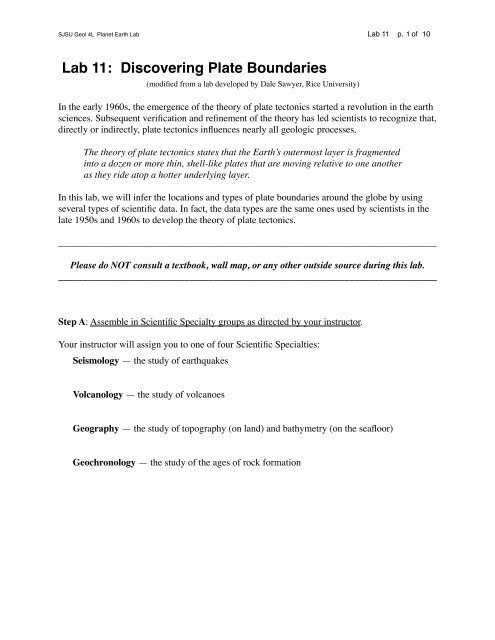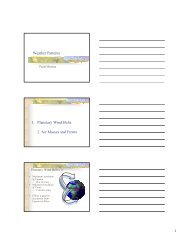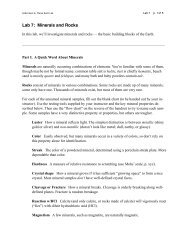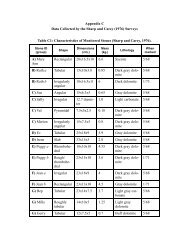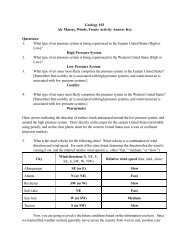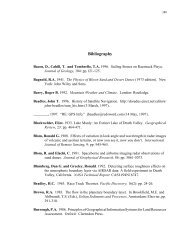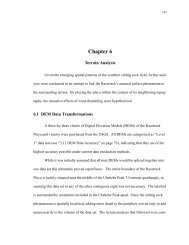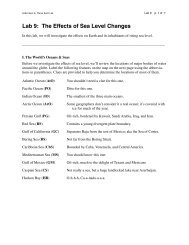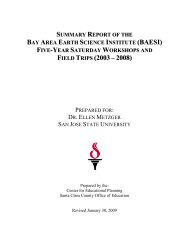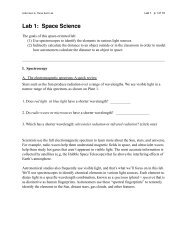Lab 11: Discovering Plate Boundaries
Lab 11: Discovering Plate Boundaries
Lab 11: Discovering Plate Boundaries
- No tags were found...
You also want an ePaper? Increase the reach of your titles
YUMPU automatically turns print PDFs into web optimized ePapers that Google loves.
SJSU Geol 4L Planet Earth <strong>Lab</strong> <strong>Lab</strong> <strong>11</strong> p. 1 of 10<strong>Lab</strong> <strong>11</strong>: <strong>Discovering</strong> <strong>Plate</strong> <strong>Boundaries</strong>(modified from a lab developed by Dale Sawyer, Rice University)In the early 1960s, the emergence of the theory of plate tectonics started a revolution in the earthsciences. Subsequent verification and refinement of the theory has led scientists to recognize that,directly or indirectly, plate tectonics influences nearly all geologic processes.The theory of plate tectonics states that the Earth’s outermost layer is fragmentedinto a dozen or more thin, shell-like plates that are moving relative to one anotheras they ride atop a hotter underlying layer.In this lab, we will infer the locations and types of plate boundaries around the globe by usingseveral types of scientific data. In fact, the data types are the same ones used by scientists in thelate 1950s and 1960s to develop the theory of plate tectonics.______________________________________________________________________________Please do NOT consult a textbook, wall map, or any other outside source during this lab.______________________________________________________________________________Step A: Assemble in Scientific Specialty groups as directed by your instructor.Your instructor will assign you to one of four Scientific Specialties:Seismology — the study of earthquakesVolcanology — the study of volcanoesGeography — the study of topography (on land) and bathymetry (on the seafloor)Geochronology — the study of the ages of rock formation
SJSU Geol 4L Planet Earth <strong>Lab</strong> <strong>Lab</strong> <strong>11</strong> p. 2 of 10Step B: Look at your group’s map and talk about what you see.For the point data (seismology, volcanology), look at distribution patterns.For surface data (geography, geochronology), look for variations in values, especially at the highand low ends of the range.Some terms to consider (this isn’t a checklist; some won’t apply to your map): present? absent? narrow? wide? straight? curved? symmetric? asymmetric? variable? constant? deep? shallow?Be especially aware of patterns, variations, etc. that suggest a major boundary is present. Thesewill be candidates for possible plate boundaries.Work as a group. Let everyone talk about what they see.Step C: Use your observations to infer the possible locations of major boundaries.1. Based on your group’s observations in Step B, use a regular lead pencil to show the locationsof possible major boundaries on the map on p. 6.2. List the specific criteria you used to infer the locations of plate boundaries. Include a sketch ifit helps, but be sure your reasoning is clear from the text you write.
SJSU Geol 4L Planet Earth <strong>Lab</strong> <strong>Lab</strong> <strong>11</strong> p. 3 of 103. Now try to divide your boundaries into “types” that share similar characteristics as expressedin your data set. Each specialty should be able to propose at least two types, and some groupsshould be able to propose up to four types. Try not to apply what you knew before coming toclass. Just use your observations as the basis for this classification attempt.Briefly list the key characteristics of each boundary type below (minimum 2, up to 4 maximum).Type 1Type 3Type 2Type 44. On your map on p. 6, label the possible boundaries that you identified in C1 with the possibletypes you proposed in C3.That’s it for the map on p. 6. Leave it as is; no modifications later! You won’t be graded onwhether it’s “right” or not, but instead on wheter your proposed boundaries are reasonablebased on the data in your particular Scientific Specialty.Step D: Reorganize into groups of 4, with one person from each Scientific Specialty per group.
SJSU Geol 4L Planet Earth <strong>Lab</strong> <strong>Lab</strong> <strong>11</strong> p. 4 of 10Step E: Share your observations and interpretations.Briefly explain to one another the following:* how you interpret the patterns and variations in the data of your Scientific Specialty* where you inferred major boundaries on the world map* the boundary types you proposed in C4, and your reasons for your classificationStep F. Develop a second map of inferred plate boundaries.Compare the locations and types of plate boundaries that each of you inferred from your particularscientific specialty. Your interpretations probably differ (which is fine).1. Reconcile the differences and propose a consensus group map of boundaries; show theseboundaries on the world map on p. 7.2. Develop a revised set of boundary types (up to 4) and describe them below.Type 1Type 3Type 2Type 4Step G. Inform your instructor after you have completed Step F.Your instructor will distribute a world map showing the positions of plate boundaries as currentlyunderstood by geoscientists. Compare your group’s map to the “professional” one. If they differin some ways, remember that the scientists have access to much more, and much more detailed,data sets than the ones we used in this lab.
SJSU Geol 4L Planet Earth <strong>Lab</strong> <strong>Lab</strong> <strong>11</strong> p. 5 of 10Step H. Obtain key facts about plate boundaries.Your instructor will give a brief presentation about the types of plate boundaries that geoscientistscurrently recognize, and will distribute a double-sided “fact sheet.”Step I. Formally classify global plate boundaries.1. Use the information from the presentation and fact sheet to classify the boundaries on the mapof the plates. Use colored pencils to distinguish the boundary types, and make sure that you addto your map a legend explaining what each color means.2. List the formally recognized boundary types below, and specify which criteria are most diagnosticof each. In other words, if you were investigating another Earth-like planet on which platetectonics operated, which features/patterns/variations/etc. would you use to infer each boundarytype? The criteria may be from any Scientific Specialty, and two or more may be diagnostic of aparticular boundary type.
SJSU Geol 4L Planet Earth <strong>Lab</strong> <strong>Lab</strong> <strong>11</strong> p. 6 of 10
SJSU Geol 4L Planet Earth <strong>Lab</strong> <strong>Lab</strong> <strong>11</strong> p. 7 of 10
SJSU Geol 4L Planet Earth <strong>Lab</strong> <strong>Lab</strong> <strong>11</strong> p. 8 of 10
SJSU Geol 4L Planet Earth <strong>Lab</strong> <strong>Lab</strong> <strong>11</strong> p. 9 of 10Web Assignment <strong>11</strong>. Earthquakes & <strong>Plate</strong> <strong>Boundaries</strong>As you learned this week in lab, most (but not all) earthquakes happen at plate boundaries. Inthis Web activity, you’ll use online resources to investigate some major historical earthquakes,from the U.S. and around the world.Earthquake PB? PB type Which plates?Anchorage, Alaska 1964Charleston, S. Carolina 1886Chile 1960Indian Ocean (Indonesia) 2004Izmit, Turkey 1999New Madrid, Missouri 18<strong>11</strong>-12northern India 1950San Francisco 1906Tokyo, Japan 1923Washington-Oregon coast 1700For each earthquake in the preceding list, answer question A below. If you answer yes to A (hint:you should for most of them!), then answer B and C also.A. Did this earthquake happen at a modern plate boundary?B. What type of plate boundary produced the earthquake?C. Which two plates are present at the boundary?For this activity, we will consider plate boundaries to be one of four types:Subduction zone: oceanic lithosphere sinks under another plate (ocean or continent)Collision zone: continental lithosphere collides with continental lithosphereDivergent: oceanic lithosphere forms, splits, and separatesTransform: two plates move horizontally past one anotherMost plate boundaries are narrow, so assume that an earthquake did NOT happen on a plateboundary if its epicenter is hundreds of kilometers away from a boundary drawn on a map.
SJSU Geol 4L Planet Earth <strong>Lab</strong> <strong>Lab</strong> <strong>11</strong> p. 10 of 10You can proceed however you like, but here are some recommended steps:* Use Google. For each earthquake, enter “epicenter earthquake year” (e.g., epicenter Chile1960) and look for a map that shows the epicenter (i.e., the point on Earth’s surface above wherethe earthquake happened).* Use either the source from Google or a map of the world’s tectonic plates(http://geology.er.usgs.gov/eastern/plates.html) to determine the answer to question A.* If the answer to A is yes, determine the answers to B and C. You might find what you need inyour links from Google, or you may find this map of plate boundaries useful:http://volcano.und.nodak.edu/vwdocs/Submarine/plates/* If you need to review the types of plate boundaries, or need other reference material on platetectonics, try this USGS Web site (an on-line text, so you may need to click around a bit):http://pubs.usgs.gov/publications/text/dynamic.htmlAnswer the following questions when you’re done with the earthquake list.<strong>11</strong>. Although the list is very short, it’s pretty representative of major earthquakes over the past200 years. Which type of plate boundary seems to have the fewest damaging earthquakes?12. Why do you think this is the case? [Hint: Consider what makes an earthquake “damaging.”]


